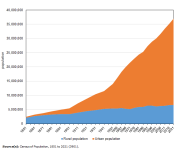Brad Sallows
Army.ca Legend
- Reaction score
- 7,189
- Points
- 1,040
Part of densification is concentrating the jobs along with the people, so it absolutely guarantees that there will be commuters - everyone who wants more living space than they can afford in the dense area. The more jobs concentrate, the more commuters.Densifying a population doesn’t mean chopping down all the trees either. It means instead of having a ton of single dwelling homes you start building upwards and have more multi-story homes, apartment buildings/condos, etc. It means not having to take a car into work for 2 hour commutes each way and wasting all that fuel idling in traffic going nowhere anytime soon.
I suspect the solution to commuting lies not in fruitlessly trying to convince people to live in stacked shoeboxes or in extraordinarily expensive mass transit infrastructure which serves only a few corridors well, but rather in distributing office jobs.
[Add: of course, the loss of commercial tenants would further crimp major municipalities' tax revenues, so they're likely to resist it bitterly and continue to exacerbate the commuting "problem".]



